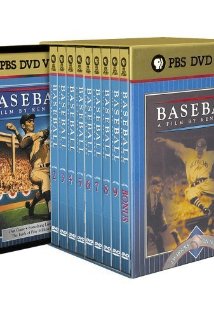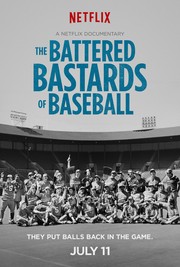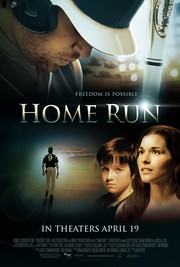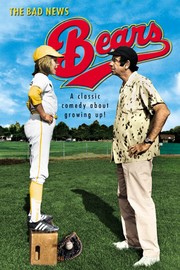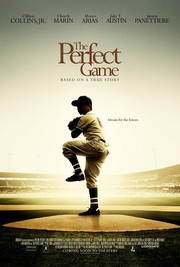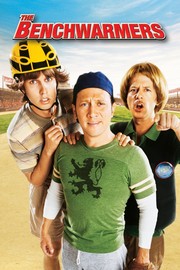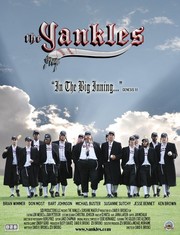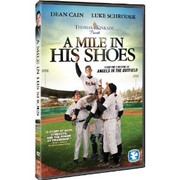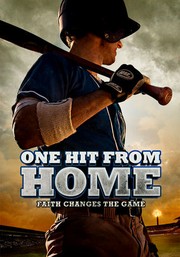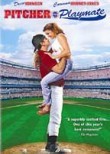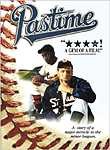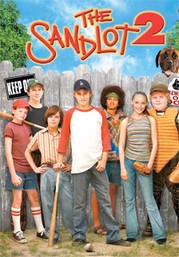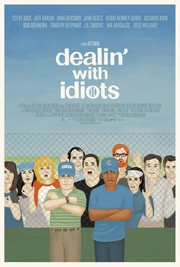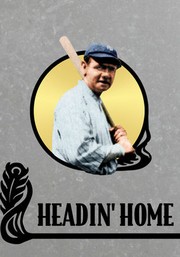GUIDE: Every Baseball Movie on Netflix
It’s baseball week at TechGraphs. To commemorate, we’re bringing you baseball-themed content all of Opening Week.
A few days before Opening Day, mostly every year, I watch The Natural. It’s been my favorite baseball movie since I was nine. Watching Roy Hobbs bust a light tower builds my excitement for the start of the baseball season. For those of you itching for some baseball outside of the opening week of Major League Baseball, I’ve compiled a list of every baseball movie currently on Netflix along with the Rotten Tomatoes audience score to serve as a helpful guide to your baseball-viewing needs.
I’m utilizing the audience score, which is based on votes from readers, rather than the Tomatometer, because I hate critics. Also, there’s a ton more scores from the audience (think 2,000 or more) than critics (around 25-ish). I’ve sorted the flicks in ascending order starting with highest audience score. Remember, people – this is Netflix. You won’t find Bull Durham. After reading the list, you may actually wish that Trouble with the Curve was streaming.
Editors note: All online comments unedited. A lot of (sic) is implied.
Year: 1994
Need to know: It’s 18 hours long. If you’re passionate about baseball, you’ll love it. If you’re not, you may fall asleep rather quickly. Binge it and tell me how that works out for ya.
Audience Score: N/A
Encapsulating comment: Brilliant documentary on the astounding history of America’s pastime with the superb direction of Ken Burns and the vast number of talents from around the world who lend their views on the classic game. Amazing footage never seen before. – Tim Cox via IMDB
The Battered Bastards of Baseball
Year: 2014
Audience Score: 95%
Need to know: This is a Netflix original documentary about the only independent baseball team in 1973 out of Oregon. From Netflix: Their spirit was contagious, and during their short reign, the Mavericks — a restaurant owner turned manager, left-handed catcher, and blackballed pitcher among them — brought independence back to baseball and embodied what it was all about: the love of the game.
Encapsulating comment: While probably better appreciated by people already invested in this world, it still offers underdog-rooting fun for the rest of us. Clearly a heartfelt look at a relatively interesting part of American sports history? May work better as an actual narrative. – Matt G
Year: 2012
Audience Score: 88%
Need to know: Narrated by John Leguizamo and including an executive producer title for Bobby Valentine, this documentary looks at MLB training camps in the Dominican Republic.
Encapsulating comment: Kinda the Hoop Dreams for baseball in the Dominican Republic. MLB does not come off looking good in this. Recommended for baseball fans. – dteller1
Year: 2013
Audience Score: 82%
Need to know: Big-time baseball player gets a DUI, agent sends him back to the small town he grew up in to coach the youth baseball team. Doc Hollywood meets a jock strap.
Encapsulating comment: It’s not as if the director and cast don’t possess The Natural quality. All involved perform their best at Stealing Home and that’s no Bull Durham. Still, every moviegoer knows the Angle in the Outfield here. Hell, when parodied in the hilarious HBO comedy Eastbound and Down, it sadly rings truer. Getting literally preached at from the pulpit, however, never feels like a great night at the movies. – Jeff Boam
Year: 1976
Audience Score: 80%
Need to know: After high school I played slow-pitch softball for about 12 years. For half that time, I had long, blonde hair, down to about my shoulders. I pretty much tried to be the adult version of Tanner. I even played shortstop. If you need to know what this movie is about, you shouldn’t be reading this post.
Encapsulating comment: This set the standard for countless sports movies, and, while it’s not so revelatory now, I’m sure it was quite shocking/refreshing to have a kids movie have such an edge to it what with the swearing and politically incorrect nature. It’s less vulgar than the remake, but while it’s more family oriented, it’s still got some racial epithets that wouldn’t fly now a days if said by white characters. – Chris Weber
Year: 1998
Audience Score: 74%
Need to know: Starring the Southpark guys, BASEketball tells the tale of three slackers who make up a new, pure and innocent sport in their driveway, only to find it turned into a major corporate and wildly popular professional league.
Encapsulating comment: Well it was watchable. – Wahida K
Year: 2011
Audience Score: 68%
Need to know: Cheech Marin is in it. A true story about the 1957 Monterrey, Mexico boys team that overcame poverty and limited resources to reach the Little League World Series. Also, Cheech Marin is in it.
Encapsulating comment: The Perfect Game is harmless and good hearted but it feels too cliche and unmemorable to be an effective sports film. – Bradley Wright
Year: 2006
Audience Score: 64%
Need to know: This looks awful. To be honest, I’ve never seen it. I just can’t look at David Spade’s haircut. Somehow it got a decent audience score. Which now makes me question my use over the critics, who HATED THIS (11%).
Encapsulating comment: The worst “comedy” that I ever saw these days. – Lucas Martins
Year: 2012
Audience Score: 63%
Need to know: A former MLBer’s career ended due to alcoholism, his wife left him and he went to prison following his third DUI. Sounds fun, huh? He ends up coaching the baseball team of an Orthodox Jewish school as part of his parole, mainly because no one else wanted him around their kids.
Encapsulating comment: The best kosher baseball movie out there, I love watching sports movies especially baseball ones, you can never have enough of them, and this ones totally kosher, so don’t be a putz or a smuck and watch it. Ralph from Happy Days is in, flashback, is pretty good, as the dad, Donny gives his Most in this part. – mike hawke
Year: 2012
Audience Score: 59%
Need to know: We have a Dean Cain sighting, people. The story of Mickey Tussler, a young man with a type of autism who is recruited by a passionate coach to pitch for his minor league team.
Encapsulating comment: Based on the novel, The Legend of Micky Tussler by Frank Nappi, comes the Canadian film, A Mile In His Shoes. While the basic story remains the same, the film was significantly different than the novel. The new story transfers much better to film, but takes far too much away from the original novel. – Todd Smith
Year: 2014
Audience Score: 57%
Need to know: Hey Hollywood – stop writing scripts about a former star that leads a crappy team to glory. IT’S BEEN DONE. This one isn’t any different. At least this guy isn’t an alcoholic like half of the other movies on this list (that I can tell).
Encapsulating comment: There are no reviews. If you’re going to watch it, make sure you’re doing laundry, or something else productive.
Year: 2005
Audience Score: 55%
Need to know: It’s a romantic comedy. Kill two birds with one stone and cross this one off your baseball movies list while scoring brownie points with your woman friend for suggesting a movie with romance.
Encapsulating comment: This was a bad movie Sunday selection by myself, but it could have been a lot worse. Acting was pretty bad and she is still pretty hot, even though this was made many years after her prime… – Ed M
Year: 1991
Audience Score: 54%
Need to know: Jeffrey Tambor (Arrested Development) and Ernie Banks appear in this story about two minor league players, both outcasts in the clubhouse, who develop a common bond over the love of the game.
Encapsulating comment: This is like one of those movies you stumble upon at 3am, sitting on your couch, flipping through channels. For some reason, it takes me back to my high school days of baseball. Good times. – kinadeon
Year: 2005
Audience Score: 41%
Need to know: I had no idea that this existed. Unfortunately for James Earl Jones, he signed on for the sequel.
Encapsulating comment: This movie is probably the worst movie I’ve ever seen in my life. This movie pretty much tries to re-make the original classic, but they fail miserably. – Japes.
Year: 2013
Audience Score: 33%
Need to know: As IFC Films noted, a hilarious satire about the culture surrounding youth baseball leagues in Los Angeles, this fully improvised film also features a who’s who of notable comedians and actors including Christopher Guest (Waiting for Guffman), Fred Willard (Modern Family), Bob Odenkirk (Breaking Bad), J.B. Smoove (Curb Your Enthusiasm), Gina Gershon (How to Make It in America), Kerri Kenney-Silver (The New Normal), Jami Gertz (The Neighbors), Timothy Olyphant (Justified), Richard Kind (Argo), Steve Agee (The New Girl), David Sheridan (The Love Boat), Nia Vardalos (My Big Fat Greek Wedding).
Yet it still sucked. Critics hated it, too (37% Tomatometer).
Encapuslating comment: funny people, but not a funny movie. a few chuckles but almost all of it misses. – Cody C
Year: 1920
Audience Score: Just six ratings, so not enough to get a score. The average rating, out of 5, was 2.8.
Need to know: The sole purpose of this picture was to make money exploiting the “King of Swat,” Babe Ruth, in his motion picture debut.
Encapsulating comment: The first movie of Babe Ruth’s not-so-illustrious acting career is this wheezy silent about a small-town lad becoming a big-time slugger. Ruth portrays someone named “Babe,” but the character’s cornball backstory has little to do with Ruth’s own history. This Babe is no troubled orphan, but a polite mama’s boy with a homemade bat and a spunky younger sister named — get this — “Pigtails.” Ruth flashes none of the wisecracking charisma you’ll hope to see, and there isn’t even any notable footage of him playing ball. Meanwhile, the title cards izz all written inna contrived, po-folks dialect that culdn’t bee mo’ condescendin’ to th’ movie’s target audience. Fer heaven’s sake, th’ Babe deserved better than this. – Eric B
30 For 30 stuff
Netflix also has some ESPN documentaries to watch, which may be far more interesting than 75 percent of the list above.
You Don’t Know Bo: The Legend of Bo Jackson
Four Days in October – Red Sox propaganda
Knuckleball! (Not a 30 For 30 production)
Silly Little Game – Charts the origins of fantasy sports games from a small lunchtime group known as the rotisserie league to the multi-million dollar industry it is today. The show also explores how none of the founders made money or even play the game anymore.
Little Big Men – The story of Cody Webster, Kirkland, WA, Little League, and the biggest upset in the history of Little League.
Made out of Japan in 2011, this….looks…awesome. Per IMDB:
Baseball prodigy Jubeh Yakyu (Tak Sakaguchi) is the most feared and dangerous juvenile delinquent in all of Japan. After accidentally causing the death of his father with a super-powered, deadly fireball pitch, Jubeh swore off baseball and became a criminal and now, at 17, has been sent to the Pterodactyl Juvenile Reformatory for hardened criminals. Headmistress Ishihara, the granddaughter of a World War II Nazi collaborator, runs the institution with an iron fist and the enthusiastic help of her sadistic assistant, Ilsa. After arriving at the hellhole, Jubeh soon learns from governor Mifune that his long-lost, younger brother Musashi had also done time there after a murder spree, but had since died mysteriously.
We need a viewing party.
